Click on images to enlarge

infestation (Photo: Sheldon Navie)

creeping habit (Photo: Sheldon Navie)

three-lobed leaves (Photo: Sheldon Navie)
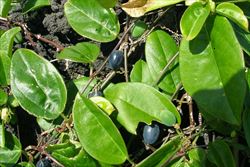
plants occasionally have entire leaves (Photo: Forest and Kim Starr, USGS)
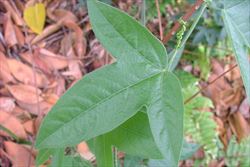
close-up of leaf (Photo: Sheldon Navie)
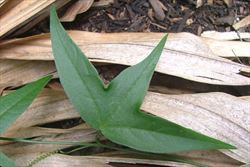
broader leaf with narrow lobes (Photo: Sheldon Navie)
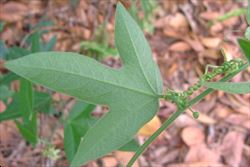
slightly hairy leaf underside and coiled tendrils (Photo: Sheldon Navie)
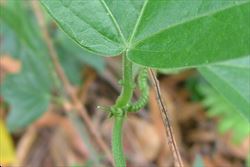
close-up of two small glands on the leaf stalk (Photo: Sheldon Navie)
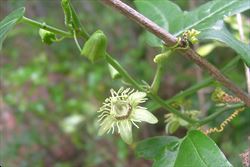
flower and flower buds (Photo: Sheldon Navie)

close-up of flower (Photo: Sheldon Navie)
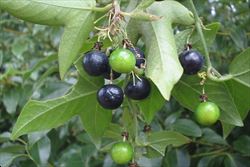
immature and mature fruit (Photo: Sheldon Navie)
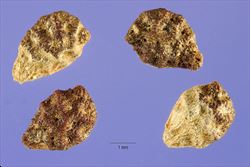
close-up of dried seeds with fleshy arils removed (Photo: Steve Hurst at USDA PLANTS Database)

seedling (Photo: Sheldon Navie)
Scientific Name
Passiflora suberosa L.
Synonyms
Passiflora suberosa L. var. minima Mast.
Family
Passifloraceae
Common Names
cork passionflower, cork-bark passion flower, cork-barked passion flower, cork-barked passionflower, corkstem passionflower, corky passion flower, corky passion vine, corky passionflower, corky passionfruit, corky stem passion vine, corky-stem passionflower, corky-stemmed passionflower, devil's pumpkin, indigo berry, pointed leaf passionfruit, small passionfruit, wild passionfruit
Origin
Native to south-eastern USA (i.e. Florida and Texas), Mexico, Central America (i.e. Belize, Costa Rica, El Salvador, Guatemala, Honduras and Panama), the Caribbean and tropical South America (i.e. French Guiana, Guyana, Surinam, Venezuela, Brazil, Bolivia, Colombia, Ecuador, Peru, northern Argentina, Paraguay and Uruguay).
Cultivation
This species has sometimes been cultivated as a garden ornamental in the past.
Naturalised Distribution
Widely naturalised in the northern and eastern parts of Australia (i.e. in northern and eastern Queensland, in the north-western parts of the Northern Territory, and in the coastal districts of northern and central New South Wales).
Also widely naturalised in other tropical regions of the world.
Habitat
A weed of closed forests, open woodlands, urban bushland, riparian vegetation, disturbed sites, waste areas and gardens in tropical, sub-tropical and warmer temperate regions.
Habit
A slender vine with a climbing or creeping habit.
Distinguishing Features
- a climber or creeper developing a corky bark at the bases of its older stems.
- its alternately arranged leaves are usually have three pointed lobes.
- its small flowers (about 1.5 cm across) are greenish or whitish in colour.
- its fruit are small bluish-black or purplish-black berries (about 1-1.5 cm across).
Stems and Leaves
The younger stems are round or sometimes angular in shape, becoming corky at the base with age. They grow up to about 6 m in length and produce tendrils in the leaf forks. These stems vary from being hairless (i.e. glabrous) to sparsely or densely hairy (i.e. pubescent).
The leaves are alternately arranged along the stems and borne on stalks (i.e. petioles) 0.5-4 cm long. The leaf blades (3-11 cm long and 4-12 cm wide) usually have three pointed lobes, but occasionally they have entire margins. At the base of the leaf stalk, there is an unbranched tendril and a small linear appendage (i.e. a stipule) 4-8 mm long.
Flowers and Fruit
The small flowers (15-25 mm across) are borne singly in the leaf forks (i.e. axils) on stalks (i.e. pedicels) 1.5-2.5 cm long. They are usually pale greenish or whitish in colour and do not have any petals. However, they have six sepals which may be mistaken for petals and five prominent stamens. They also have an ovary with three styles that are topped with large stigmas. Flowering occurs throughout most of the year.
The fruit are rounded berries (about 1-1.5 cm across) and turn from green to bluish-black or purplish-black as they mature. They contain numerous wrinkled seeds (3-4 mm long).
Reproduction and Dispersal
This species reproduces by seed, which are mainly spread by birds and other animals that eat its fruit.
Environmental Impact
Corky passion vine (Passiflora suberosa) is regarded as an environmental weed in Queensland and New South Wales.
Legislation
Not declared or considered noxious by any state government authorities.
Management
For information on the management of this species see the following resources:
- the Biosecurity Queensland Fact Sheet on this species, which is available online at http://www.dpi.qld.gov.au.
Similar Species
Corky passion vine (Passiflora suberosa) can be distinguished from two other similar species, white passion flower (Passiflora subpeltata) and stinking passion vine (Passiflora foetida), by its leaves. White passion flower (Passiflora subpeltata) has hairless leaves with three rounded lobes and stinking passion vine (Passiflora foetida) has hairy leaves with three pointed lobes, while corky passion vine (Passiflora suberosa) has hairless leaves with three pointed lobes. The flowers and fruit of corky passion vine (Passiflora suberosa) are also much smaller than those of the other species.

